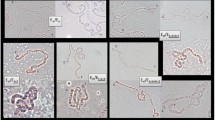Abstract
Adult flies of Drosophila subobscura were kept in a refrigerator for 72 days. The animals belonged to a second generation derived from a cross between two homokaryotypic stocks. One of these was homozygous for the Standard (St) gene arrangement of the U-chromosome, the other one for the gene arrangement U1+2, which differs from the USt by two inversions. Both gene arrangements are abundant in natural populations of Northern and Central Europe.
According to Mendelian expectations the karyotypes USt/St, USt/1+2 and U1+2/1+2 should show up in the second generation in conformity with the proportion 1 : 2 : 1. A random sample of 70 adults taken before confining the animals to the refrigerator contained 11 : 43 : 16 specimens of the above mentioned karyotypes respectively. Karoytypic proportions observed after keeping the flies in the cold were therefore compared not only with the hypothetical 1 : 2 : 1 proportion but also with the 11 : 43 : 16 proportion of that prior sample. There was however no significant deviation from the latter proportion. For both males and females the result remained the same, independent of whether or not they had copulated. Animals which had been kept and normally fed for the same duration at 18°C showed no significant deviation from the initial karyotype proportion, either. Thus the attempt to show through karyotype proportions an adaptation to long periods of cold was entirely unsuccessful.
In a second run I buried eggs, the three larval stages, and pupae as well as adults into the forest soil in autumn for exposure to the winter cold. A sample was removed 125 days later, the remaining 180 days after having been dug in. As in the first run the flies showed no significant changes in karyotype proportions. While death rate seemed to be homogeneous, the three karyotypes nevertheless showed some differences in viability.
In laboratory tests, those male and female specimens which had not copulated withstood the cold better. The highest mortality rate occurred among sexually mixed groups. Further, a shorter life span and lower fertility rate were found in animals kept at 18°C than in those kept in the refrigerator.
Among the animals that had been dug into the forest soil only those survived, which had started the cold period as immature stages. They developed very slowly. These ecological findings suggest that Drosophila subobscura hibernates in its immature stages rather than as adult flies.
Very young larvae were found to have the best chance of survival. This observation led to a third experiment: I exposed young larvae to a cold shock treatment. Thereby a first hint was obtained concerning the presumed differences in adaptive capacities of different karyotypes. After a cold shock the development of the homokaryotypes, from the egg to the larval stage, was faster and in one case there even emerged more homokaryotype than heterokaryotype larvae.
Similar content being viewed by others
Literatur
Bilewicz, S. (1953). Experiments on the effect of reproductive functions on the length of life in Drosophila melanogaster. Folia biol. 1: 177–194.
Burla, H. & W. Götz (1965). Veränderlichkeit des chromosomalen Polymorphismus bei Drosophila subobscura. Genetica 36: 83–104.
Dobzhansky, T. (1962). Rigid vs. flexible chromosomal polymorphism in Drosophila. Americ. Nat. 96: 321–328.
Hadorn, E. (1955). Letalfaktoren in ihrer Bedeutung für Erbpathologie und Genphysiologie der Entwicklung. Georg Thieme Verlag, Stuttgart.
Hannah, A. & J. Puro with the assistance of P. Heinonen, S. Roman & L. Seppälä (1964). The brood pattern of fecundity of Drosophila melanogaster males mated singly and sequentially up to 24 days. Drosophila Information Service 39: 122–124.
Krimbas, C. B. (1964). The genetics of Drosophila subobscura populations. I. Inversion polymorphism in populations of Southern Greece. Evolution 18: 541–552.
Kummer, H. (1960). Experimentelle Untersuchungen zur Wirkung von Fortpflanzungs-Faktoren auf die Lebensdauer von Drosophila melanogaster Weibchen. Z. vergl. Physiol. 43, Heft 6: 642–679.
Kunze-Muehl, E. & D. Sperlich (1958). Inversionen und chromosomale Strukturtypen bei Drosophila subobscura. Z. indukt. Abstamm.-und Vererb.-Lehre 87: 65–84.
Kunze-Muehl, E., E. Mueller & D. Sperlich (1958). Qualitative, quantitative und jahreszeitliche Untersuchungen über den chromosomalen Polymorphismus natürlicher Populationen von Drosophila subobscura Coll. in der Umgebung von Wien. Z. Vererbungsl. 89: 636–646.
Mohn, N. & E. B. Spiess (1963). Cold resistance of karyotypes in Drosophila persimilis from Timberline of California. Evolution 17: 548–563.
Pearl, R. (1920). The biology of death. J. B. Lippincot Company, Philadelphia and London.
Pentzos-Daponte, A. (1964). Qualitative und quantitative Untersuchungen über den chromosomalen Polymorphismus natürlicher Populationen von Drosophila subobscura in der Umgebung von Thessaloniki/Griechenland. Z. Vererbungsl. 95: 129–144.
Prevosti, A. (1964). Chromosomal polymorphism in Drosophila subobscura populations from Barcelona (Spain). Genet. Res. 5: 27–38.
Smith, M. J. (1958). The effects of temperature and of egg-laying on the longevity of Drosophila subobscura. J. exp. Zool. 35: 832–842.
Stumm-Zollinger, E. (1953). Vergleichende Untersuchung über die Inversionshäufigkeit bei Drosophila subobscura in Populationen der Schweiz und Südwesteuropas. Z. ind. Abst. Vererbungsl. 85: 382–407.
Author information
Authors and Affiliations
Rights and permissions
About this article
Cite this article
Risch, P. Die überwinterung als adaptive leistung, Geprüft an verschiedenen karyotypen der inversionspolymorphen art Drosophila subobscura . Genetica 42, 79–103 (1971). https://doi.org/10.1007/BF00154842
Received:
Accepted:
Issue Date:
DOI: https://doi.org/10.1007/BF00154842



